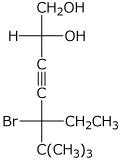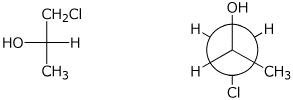|
|
Organic Chemistry I |
|
Professor Carl C. Wamser |
||
Exam 3 Answer Key |
![]()
|
|
Organic Chemistry I |
|
Professor Carl C. Wamser |
||
Exam 3 Answer Key |
![]()
1. (15 points) Write complete names for each of the following, including stereochemistry if it is specifically shown.
a) 
(2E,5S)-3-ethyl-5-methylnon-2-en-7-yn-5-ol
b) 
(2R,5S)-5-bromo-5-ethyl-6,6-dimethylhept-3-yn-1,2-diol
c) 
(2S,3S,4Z)-2,6-dichloro-3-methylhex-4-en-3-ol
2. (15 points) Write accurate structures for the following:
a) the enantiomer of (R)-1,2-butanediol
b) two isomers of C3H8O : a polar, protic solvent and a polar, aprotic
solvent
(be sure to indicate which is which)
c) the expected rate law for hydrolysis of t-butyl bromide
d) the enol intermediate in the hydration of 2-butyne
e) the geminal dibromide that would be the preferred precursor to 1-butyne
3. (10 points) Identify the relationships between the pairs of structures shown below using ONE of the following indications for each pair:
I - identical, C - constitutional isomers, D - diastereomers,
E - enantiomers, F - conformational isomers, O - other
a)  I
I
b)  D
D
c)  O
O
d)  D
D
e)  E
E
4. (15 points) Arrange the following in order with respect to the property
indicated.
Write MOST and LEAST under the compounds with the highest and
lowest values, respectively.
a) nucleophilicity
LEAST / / MIDDLE / / MOST
b) rate of reaction with water
MOST / / MIDDLE / / LEAST
c) number of possible stereoisomers
LEAST / / MOST / / MIDDLE
MOST / / MIDDLE / / LEAST
e) ratio of substitution / elimination products upon reaction with KOH in ethanol
MOST / / MIDDLE / / LEAST
5. (15 points) Complete each of the following reactions by adding the missing part: either the starting compound, the necessary reagents and conditions, or the final major product. Show stereochemistry if it is specific.
a) 
b) 
c) 
d) 
e) 
6. (20 points) The tosylate shown below was prepared in optically pure form with the stereochemistry indicated. It reacted slowly in water to form a mixture of 2-methyl-2-pentanol and 2-methyl-3-pentanol. Write a complete mechanism for the reaction. Show all steps and electron-pushing arrows for each step. Show how each of the two products are formed.
Pure (R)-2-methyl-3-pentanol is known to have a specific rotation of
+60°.
The 2-methyl-3-pentanol isolated from the hydrolysis above gave a specific
rotation of
- 30°. Describe the 2-methyl-3-pentanol product in terms of
optical purity = 50%
enantiomer excess = 50%
% of each enantiomer present = 75% (S) and 25% (R)
Explain why there is not an equal amount of each enantiomer, referring to your mechanism to indicate why one enantiomer may be preferred.
When the water adds, it will be easier to add on the side opposite the leaving group. This gives mostly inversion, i.e., (S) product is formed in greater yield than (R) product. The preference could be because there is some SN2 mechanism occurring, or because the leaving group anion is still present near the carbocation (an ion pair).
7. (10 points) Create a synthetic sequence that could prepare the compound shown
below.
You may use any alkyl halide with two or fewer carbons and acetylene as the only
sources of the carbons in the final product.
![]()